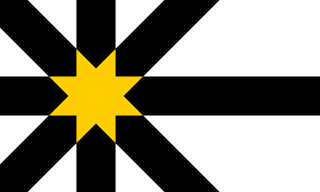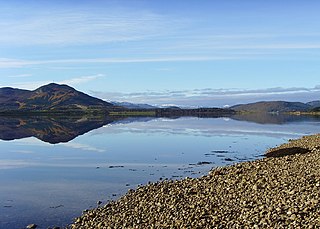Related Research Articles

Sutherland is a historic county, registration county and lieutenancy area in the Highlands of Scotland. The name dates from the Viking era when the area was ruled by the Jarl of Orkney; although Sutherland includes some of the northernmost land on the island of Great Britain, it was called Suðrland from the standpoint of Orkney and Caithness.

Fort George is a large 18th-century fortress near Ardersier, to the north-east of Inverness in the Highland council area of Scotland. It was built to control the Scottish Highlands in the aftermath of the Jacobite rising of 1745, replacing a Fort George in Inverness constructed after the 1715 Jacobite rising to control the area. The current fortress has never been attacked and has remained in continuous use as a garrison.

Bonar Bridge is a village on the north bank of the Kyle of Sutherland to the west and the Dornoch Firth to the east in the Parish of Creich in the Highland council area of Scotland.

The Battle of Glen Shiel took place on 10 June 1719 in the Scottish Highlands, during the Jacobite rising of 1719. A Jacobite army composed of Highland levies and Spanish marines was defeated by British government troops.

The Lovat Scouts was a British Army unit first formed during the Second Boer War as a Scottish Highland yeomanry regiment. They were the first known military unit to wear a ghillie suit, and were renowned for their elite reconnaissance capabilities. In 1916, the Lovat Scouts formally became the British Army's first sniper unit, then known as "sharpshooters". The regiment served in the First World War and Second World War.

George Granville Sutherland-Leveson-Gower, 5th Duke of Sutherland, KT, PC, styled Earl Gower until 1892 and Marquess of Stafford between 1892 and 1913, was a British courtier, patron of the film industry and Conservative party politician from the Leveson-Gower family. He held minor office in the Conservative administration of Bonar Law and Stanley Baldwin in the 1920s and was later Lord Steward of the Household from 1935 to 1936. As a noted patron of the British film industry, the Sutherland Trophy, awarded by the British Film Institute, is named in his honour.

Sir Robert Munro, 6th Baronet was a Scottish military officer and politician whose life followed an 18th-century pattern. He fought in support of the Revolution Settlement and the House of Hanover, and their opposition to all attempts by the Jacobites to restore the House of Stuart either by force of arms or by political intrigue. He was killed at the Battle of Falkirk Muir in 1746.
The 93rd Regiment of Foot was a Line Infantry Regiment of the British Army, raised in 1799. Under the Childers Reforms, it amalgamated with the 91st Regiment of Foot to form the Argyll and Sutherland Highlanders.
Loudon's Highlanders, or the 64th Highlanders, or Earl of Loudon's Regiment of Foot, was an infantry regiment of the British Army.
Lieutenant General Sir Chandos Blair, was a senior British Army officer who served as General Officer Commanding Scottish Command from 1972 to 1976.

Rosehall is a remote hamlet in the Parish of Creich near the confluence of the River Cassley and the River Oykel, 1 mile northwest of Altass, in Sutherland, Scottish Highlands and is in the Scottish council area of Highland. It is the site of the main road bridge over the Cassley, which is just downstream from the Achness Waterfall, commonly known simply as the Cassley Falls.

The siege of Brahan took place in Scotland in November 1715 and was part of the Jacobite rising of 1715. Highlanders loyal to the British-Hanoverian government of George I of Great Britain laid siege to Brahan Castle, seat of William Mackenzie, 5th Earl of Seaforth, who was a staunch Jacobite, loyal to the House of Stuart.
The plan of raising a fencible corps in the Highlands was first proposed and carried into effect by William Pitt the Elder, in the year 1759. During the three preceding years, both the fleets and armies of Great Britain had suffered reverses, and it was thought that a "home guard" was necessary as a bulwark against invasion.
The Independent Highland Companies were irregular militia raised from the Scottish clans of the Scottish Highlands by order of the Scottish government between 1603 and 1760 in order to help keep the peace and enforce the law in the Highlands and were recognized as such by the government. The officers of the Independent Highland Companies were commissioned as officers of the British Army but the Independent Companies were not recognized as official regiments of the line of the army. The Independent Highland Companies were the progenitors of the Highland Regiments of the British Army that began when ten Independent Highland Companies were embodied to form the Earl of Crawford's Highland Regiment that was numbered the 43rd Regiment of Foot in 1739.
The New Year Honours 1910 were appointments by King Edward VII to various orders and honours to reward and highlight good works by members of the British Empire. They were announced on 4 January 1910.
Captain Sir John David Bingham Younger KCVO was a British public servant who was the Lord Lieutenant of Tweeddale from 1994 to 2014. He retired on reaching the age of seventy-five.

Colonel Sir Donald Hamish Cameron of Lochiel, was a British Army officer, landowner and the 26th Chief of Clan Cameron. He served as commanding officer of the Lovat Scouts throughout the Second World War. He succeeded his father as Chief of the Camerons in 1951 and later served as Lord Lieutenant of Inverness-shire.

The Battle of Dornoch took place on 20 March 1746 and was part of the Jacobite rising of 1745 in Scotland. However, although recorded in history as a "battle" there was no actual fighting between the two sides. Instead a large rebel Jacobite force advanced on a position held by a force loyal to the British-Hanoverian Government who were taken by surprise and forced into a retreat. The Jacobite advance was coordinated by James Drummond, 3rd Duke of Perth at Dornoch, Sutherland.
George Mackay, 3rd Lord Reay (1678–1748), was a Scottish noble and chief of the Clan Mackay, a Scottish clan of the Scottish Highlands. During his life the Glorious Revolution took place which directly affected his family and estate, and during his chiefdom he served the British-Hanoverian Government during the Jacobite rising of 1715 and the Jacobite rising of 1745.
Lieutenant-Colonel Sir James Stirling of Garden, was a British army officer and chartered surveyor, who served as Lord Lieutenant of Stirling and Falkirk from 1983 to 2005.
References
- 1 2 3 4 5 6 7 8 9 "Sir Allan Gilmour Soldier and former lord lieutenant of Sutherland". heraldscotland.com. The Herald. 26 September 2003. Retrieved 27 June 2020.
- ↑ "102 – RECORDS OF THE MEN OF LOCHBROOM". themenoflochbroom.com. August 2014. Retrieved 27 June 2020.
- ↑ Clune, John V. (19 July 2017). "2: Independent and International: Ghanas National Military and American Assistance Policy". The Abongo Abroad: Military-Sponsored Travel in Ghana, the United States, and the World, 1959-1992. Nashville: Vanderbilt University Press. pp. 64–66. ISBN 978-0826521514 . Retrieved 27 June 2020.
- ↑ O'Leary, David; Love, David (2 February 2015). "Lady Gilmour killed in Sutherland fire tragedy". www.scotsman.com. The Scotsman. Retrieved 27 June 2020.
- ↑ "Woman believed dead after country house fire in Sutherland". bbc.co.uk. British Broadcasting Corporation. 2 February 2015. Retrieved 27 June 2020.